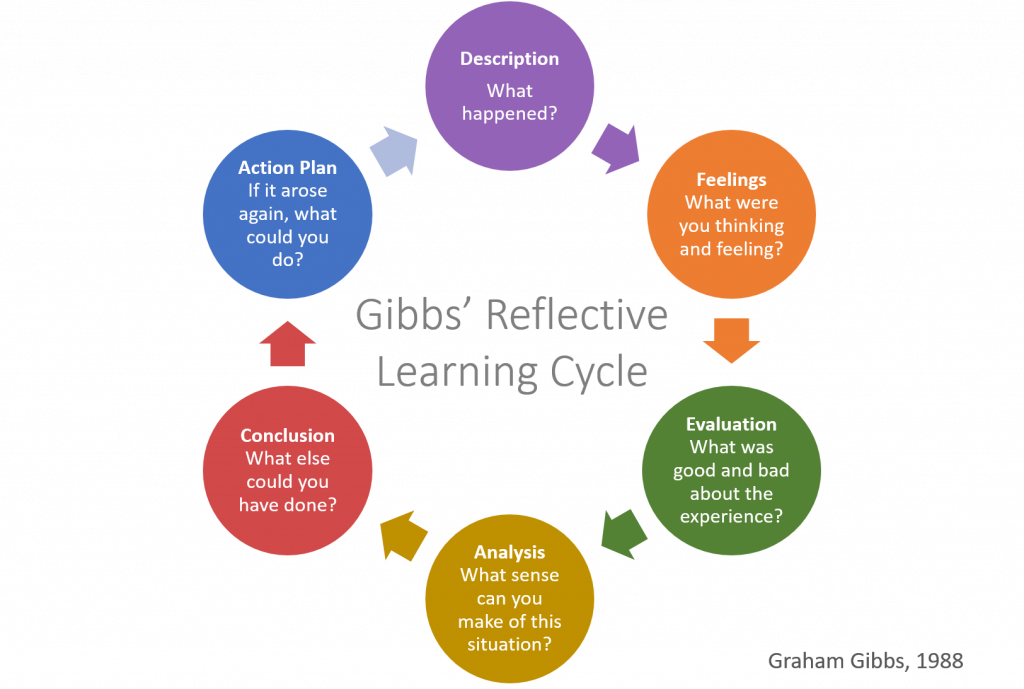
A day in the life of a primary school teacher is not simply teaching children how to tell the time, or the difference between an adjective and a verb; there is so much more to it. As I have ventured into the world of primary teaching at St. Patrick’s Primary School Moneymore https://www.stpatricksmoneymore.co.uk/, I’ve come to realise that it is a far more complex field than I thought. I’ve had hundreds of prods and pokes from children asking to get a drink or to go to the bathroom, and listened to more tattles and tales than I thought humanly possible. After gaining an insane amount of patience, I have come to learn that with all the tasks and tantrums in the classroom, there is no dull moment in a teacher’s life; each day is unpredictable. This blog reflects on my experiences of placement at this primary school in reference to Gibb’s cycle (Graham Gibbs, 1988), and how I dealt with different issues and obstacles regarding misbehaviour in the classroom.

THE FIRST DAY
On my first visit to the primary school, I found managing the children’s behaviour to be quite a challenge. Certain children were chatting amongst each other or fiddling with something under their desks instead of listening to the teacher’s instructions. I looked over at them and pointed to the board so that they would pay attention, however, my method was not successful. They would glance up for a moment and go straight back to doing their own thing. I soon realised that my approach was too soft and perhaps the children thought that my methods were not convincing. Thus, I knew I needed to take a different and more demanding approach. I decided to speak directly and in a serious tone to the children so that they understood the importance of listening to the teacher and to assert my position as a leader in the classroom, “You need to pay attention to the board or you won’t know what to do for the next task”. Simon Ellis states in his book Behaviour for Learning: Promoting Positive Relationships in the Classroom, that you should be “implementing any sanctions with care, compassion and clarity” [1]. Following this rule, I made an effort to be careful with my words as to come across as encouraging, not disrespectful. This proved to be more effective than my previous efforts as the children began to pay more attention. Unfortunately, this feeling of self-fulfilment was short lived because after ten minutes, the children became unsettled again and it became a repeating cycle of these methods. Thus, I knew I needed to do more.
After becoming more observant in the classroom, I began to notice the children acting out of order frequently and knew it needed to be dealt with. Even the teacher who has the eye of a hawk occasionally missed the odd act of mischief! The children were doing their weekly numeracy test, when I noticed one child had snatched a test paper off their desk buddy to copy their answers. Flabbergasted, I swiftly made my way over to order this child not to do this. After reading the book: Responsive Classroom: Responding to Misbehaviour, by Kathryn Brady, I followed her method of dealing with misbehaved children. Brady’s method of using visual and verbal cues, “given in a direct tone with neutral body language are more likely to be heard as helpful cues” [2]. Thus, I made a point to make eye contact with the child to make it aware that I witnessed their bad behaviour. When approached, I told the child, “This is a test. You are capable of doing it yourself instead of copying your friend’s answers. It is not nice to snatch things from others, please don’t do that again”. I felt that it was important to inform the child that this was not a nice thing to do, but made sure I was still keeping a positive morale so that the child would not become upset. After some encouragement and talking through the instructions of the test again, the child began to complete the test in a more behaved manner. I felt satisfied knowing the child acknowledged their mistake and once spoken to, they apologised to the other pupil. It finally made me feel like I was being acknowledged as a role model to the pupils since experimenting with this method. In the future, it would be best to tell the children before beginning that the test is to be completed independently and to cover their work so they don’t copy off each other.
[3]“Being a role model is the most powerful form of educating”
John Wooden
MY First big responsibility
I was given the opportunity of working with the Primary 4 pupils teaching them about how to tell the time. They each had their own individual clocks and when given a time, they would display it on the clock and show it to the group. This exercise proved to be very effective as it was a fun activity the children could be hands-on with. I really enjoyed this exercise as I finally got the opportunity to put my teaching skills to use. However, as this exercise took place just outside of the classroom, the miniscule sense of adventure caused the children to become unsettled very quickly and lost focus after a few demonstrations. After trying my best to settle them down, the teacher came out to scold the children for being too loud. I still felt that the children would not listen to my instructions and would not settle when I ordered them to, and I began to lose hope. Perhaps, they still did not take me seriously as a leader. In the future, to prevent this I would be clearer with my instructions and ask them to complete the activity in a quiet and efficient manner so as to not disrupt the other children.

finally making a difference
Upon further visits to the primary school and developing an understanding of each pupil in the classroom, I decided to have a word with the teacher in the class and asked for advice in how to control the children’s behaviour properly. After further discussion with the teacher, we came up with the strategy of revisiting the classroom rules so student’s were made aware of them. We engaged in a circle time activity where we revised the classroom rules and how these must be followed. Brady states that, “we need to let students know that the rules are important and must be taken seriously” [4]. We discussed how making mistakes is normal for every human being, but being disobedient is different and how they need to work on that. We then had a sheet prepared for all students so they could record the classroom rules and then they signed their names at the bottom to ensure that they would follow them for the remainder of the year, and we put them up on display. I feel that this exercise proved to be very effective and I saw a noticeable difference in the children’s behaviour during my visits following this activity. The use of a visual aid has now made the days a lot easier for the teacher and I, and it helps to mould the children into better behaved pupils.
In addition to this, we also created a chart for each table to award points for good behaviour in the classroom, and by the end of the week the children were given golden time and were each given a dip into the prize box to reward their good behaviour. Simon Ellis stated in their book, that a key part of promoting good behaviour in the classroom is the “effective use of positive feedback and rewards”[5]. Since implementing this, it has proven to be quite successful as it encouraged the pupils to behave better in order to earn their reward time and a prize at the end of the week. I believe that teamwork is very important between the teacher and the classroom assistant, and by working together, we have made the classroom a better place for everyone. Now that I have seen first-hand how a fun activity can instil better behaviour in pupils, it is definitely something I will use in my future teaching career if a similar problem arises.
As I have observed so far, teaching is an unpredictable career. I have a profound appreciation for the teacher’s ability to juggle thirty kids alone. With all the experience and information I have gathered, I believe now that I am better equipped for a future career in teaching. Despite all the chaos I’ve experienced so far, I look forward to completing my placement for the remainder of the year having gathered a good understanding of how to deal with children’s behaviour in the classroom.
Word Count: 1500
References
[1] Ellis, S., & Tod, J. (2018). Behaviour for Learning: Promoting Positive Relationships in the Classroom (2nd ed.). Routledge. Page 43. Available at: https://doi.org/10.4324/9781315232256 – Accessed 13 Nov. 2023.
[2] Brady, Kathryn, Mary Beth Forton, and Deborah Porter. “Responding to Misbehavior.” The Education digest 77.7 (2012): 25-. Print. Page 65. – Accessed 12 Nov. 2023.
[3] Wooden, John. Wooden: A Lifetime of Observations and Reflections on and off the Court. McGraw Hill Professional, 1997. – Accessed 11 Nov. 2023.
[4] Brady, Kathryn, Mary Beth Forton, and Deborah Porter. “Responding to Misbehavior.” The Education digest 77.7 (2012): 25-. Print. Page 213. – Accessed 12 Nov. 2023.
[5] Ellis, S., & Tod, J. (2018). Behaviour for Learning: Promoting Positive Relationships in the Classroom (2nd ed.). Routledge. Page 2. Available at: https://doi.org/10.4324/9781315232256 – Accessed 13 Nov. 2023.